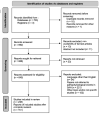Compartmental Cerebrospinal Fluid Events Occurring after Subarachnoid Hemorrhage: An "Heparin Oriented" Systematic Review
- PMID: 37175544
- PMCID: PMC10178276
- DOI: 10.3390/ijms24097832
Compartmental Cerebrospinal Fluid Events Occurring after Subarachnoid Hemorrhage: An "Heparin Oriented" Systematic Review
Abstract
Subarachnoid hemorrhage (SAH) represents a severe acute event with high morbidity and mortality due to the development of early brain injury (EBI), secondary delayed cerebral ischemia (DCI), and shunt-related hydrocephalus. Secondary events (SSE) such as neuroinflammation, vasospasm, excitotoxicity, blood-brain barrier disruption, oxidative cascade, and neuronal apoptosis are related to DCI. Despite improvement in management strategies and therapeutic protocols, surviving patients frequently present neurological deficits with neurocognitive impairment. The aim of this paper is to offer to clinicians a practical review of the actually documented pathophysiological events following subarachnoid hemorrhage. To reach our goal we performed a literature review analyzing reported studies regarding the mediators involved in the pathophysiological events following SAH occurring in the cerebrospinal fluid (CSF) (hemoglobin degradation products, platelets, complement, cytokines, chemokines, leucocytes, endothelin-1, NO-synthase, osteopontin, matricellular proteins, blood-brain barrier disruption, microglia polarization). The cascade of pathophysiological events secondary to SAH is very complex and involves several interconnected, but also distinct pathways. The identification of single therapeutical targets or specific pharmacological agents may be a limited strategy able to block only selective pathophysiological paths, but not the global evolution of SAH-related events. We report furthermore on the role of heparin in SAH management and discuss the rationale for use of intrathecal heparin as a pleiotropic therapeutical agent. The combination of the anticoagulant effect and the ability to interfere with SSE theoretically make heparin a very interesting molecule for SAH management.
Keywords: blood brain barrier; cytokines; delayed cerebral ischemia; heparin; neuroinflammation; subarachnoid hemorrhage; vasospasm.
Conflict of interest statement
The authors declare no conflict of interest.
Figures



Similar articles
-
Interventions for altering blood pressure in people with acute subarachnoid haemorrhage.Cochrane Database Syst Rev. 2021 Nov 17;11(11):CD013096. doi: 10.1002/14651858.CD013096.pub2. Cochrane Database Syst Rev. 2021. PMID: 34787310 Free PMC article.
-
Traumatic brain injury and intracranial hemorrhage-induced cerebral vasospasm: a systematic review.Neurosurg Focus. 2017 Nov;43(5):E14. doi: 10.3171/2017.8.FOCUS17431. Neurosurg Focus. 2017. PMID: 29088959
-
Endothelin receptor antagonists for subarachnoid hemorrhage.Cochrane Database Syst Rev. 2012 Sep 12;2012(9):CD008354. doi: 10.1002/14651858.CD008354.pub2. Cochrane Database Syst Rev. 2012. PMID: 22972119 Free PMC article.
-
Lipid peroxidation metabolites as biomarkers in patients with aneurysmal subarachnoid hemorrhage and cerebral vasospasm or delayed cerebral ischemia: a systematic review.Neurosurg Rev. 2025 Jun 20;48(1):516. doi: 10.1007/s10143-025-03662-3. Neurosurg Rev. 2025. PMID: 40540084 Free PMC article. Review.
-
Effect of pharmaceutical treatment on vasospasm, delayed cerebral ischemia, and clinical outcome in patients with aneurysmal subarachnoid hemorrhage: a systematic review and meta-analysis.J Cereb Blood Flow Metab. 2011 Jun;31(6):1443-51. doi: 10.1038/jcbfm.2011.7. Epub 2011 Feb 2. J Cereb Blood Flow Metab. 2011. PMID: 21285966 Free PMC article.
Cited by
-
Volumetric Assessment of Perimesencephalic Subarachnoid Hemorrhage.Neurol Ther. 2025 Aug 22. doi: 10.1007/s40120-025-00813-y. Online ahead of print. Neurol Ther. 2025. PMID: 40844796
-
Delayed Cerebral Ischemia After Aneurysmal Subarachnoid Hemorrhage: The Role of the Complement and Innate Immune System.Transl Stroke Res. 2025 Feb;16(1):18-24. doi: 10.1007/s12975-024-01290-5. Epub 2024 Aug 21. Transl Stroke Res. 2025. PMID: 39168941 Free PMC article. Review.
-
Cerebrospinal fluid analysis and changes over time in patients with subarachnoid hemorrhage: a prospective observational study.J Anesth Analg Crit Care. 2025 Jun 12;5(1):31. doi: 10.1186/s44158-025-00250-1. J Anesth Analg Crit Care. 2025. PMID: 40506779 Free PMC article.
-
Perimesencephalic Subarachnoid Hemorrhage Bleeding Patterns Are Not Always Benign: Prognostic Impact of an Aneurysmal Pathology.Biomedicines. 2025 Jun 12;13(6):1444. doi: 10.3390/biomedicines13061444. Biomedicines. 2025. PMID: 40564163 Free PMC article.
References
Publication types
MeSH terms
Substances
LinkOut - more resources
Full Text Sources
Research Materials

